Below is the story of the liberation of Axel by the Poles in September 1944 as it was seen and remembered by Mr Jaap Geensen, who lived there as a little boy. This story has also an universal appeal, because let’s see those events through the eyes of civilians. We wish to thank to Mr Geensen much for writing this story for us and for his time he had to spend over it. Also for all necessary notices and corrections.
Renata and Han.
AXEL 1944 – 2014 REMEMBERED
Germans in Zeeuws-Vlaanderen
In February 1942, the 712th Infantry Division came to Zeeuws-Vlaanderen. They took their headquarters in Oost burg. Their job was to build and man the Atlantic Wall from Terneuzen to Blankenberge on the Belgian coast. In case of an invasion they were also responsible for the area behind the coast.
burg. Their job was to build and man the Atlantic Wall from Terneuzen to Blankenberge on the Belgian coast. In case of an invasion they were also responsible for the area behind the coast.
Photo: Zeeuws-Vlaanderen
They had no tanks, only some self propelled artillery pieces. The division was a stationary one, not mobile. They had some cars,trucks, and horses of course. But, in case of a move, they were to use the train or the majority had to walk. In August 1944 they were prepared and ready. What happened is that after the closing of the Falaise Gap in France (Aug. 15th) there was a break-through of British and Canadian armour (including 1st Polish Armoured Division) collums in the direction of Northern France and Belgium.
The Supreme Commander in Berlin had a brilliant plan (or more likely panic): The 712th I.D. was to march on August 31 in the direction of Lille and from there proceed to the East, thus cutting off the Allied troops from their mainforce and supply lines. The712th had no choice but to leave their bunkers and strongholds and most of their supplies behind and start “walking”. So they did. The first days of September they had the confrontation with the moving tank collums near the Canal de Bassée. They were no match and on Sept. 47th they were ordered to retreat. Sepember 10th they settled in the Eastern part of Zeeuws-Vlaanderen with Head Quarters in Axel.
Axel – the view on the south part from the windmill on the Molen street
On September 3rd Brussels had been liberated and on the 4th Antwerp. Instead of cutting the lead force of the Allies off, the 712th I.D. themselves were now cut off and so was the rest of the 15thth Army (120.000 men). Escape was only possible across the river Schelde (5 KM wide) with tw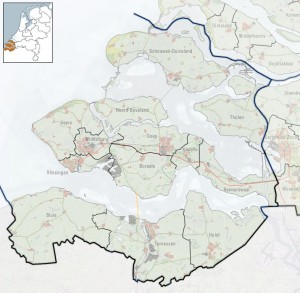 o harbours on the South bank: Terneuzen in the East and Breskens in the West, near the mouth of the river. The 712th installed themselves behind a defense line of innundated land running from West to East across the Eastern part of Zeeuws-Vlaanderen. They integrated some stray units that kept coming in from the South. On the 14th the Division issued a Division Order, outlining the plans for the days to come. The shipping across from Terneuzen was planned to begin on the 10th. The rearguard defence was to focus on keeping the ennemy artillery out of the reach of the shipping zone in Terneuzen in order to enable the shipping of the troops that were still to be ferried across. No weapons to be left behind. After crossing reassembly was planned in Heerle a village 6 Km’s North East of Bergen op Zoom. Lists were prepared about material and manpower per unit to be shipped. Bridges to be blown only after consulting the commander of the local units in order to make evacuation of personnel and material possible. All was very well planned and organised on short notice. Not an army in distress or confusion so caracteristic for the advancing allies during the second half of August 1944.
o harbours on the South bank: Terneuzen in the East and Breskens in the West, near the mouth of the river. The 712th installed themselves behind a defense line of innundated land running from West to East across the Eastern part of Zeeuws-Vlaanderen. They integrated some stray units that kept coming in from the South. On the 14th the Division issued a Division Order, outlining the plans for the days to come. The shipping across from Terneuzen was planned to begin on the 10th. The rearguard defence was to focus on keeping the ennemy artillery out of the reach of the shipping zone in Terneuzen in order to enable the shipping of the troops that were still to be ferried across. No weapons to be left behind. After crossing reassembly was planned in Heerle a village 6 Km’s North East of Bergen op Zoom. Lists were prepared about material and manpower per unit to be shipped. Bridges to be blown only after consulting the commander of the local units in order to make evacuation of personnel and material possible. All was very well planned and organised on short notice. Not an army in distress or confusion so caracteristic for the advancing allies during the second half of August 1944.
Poles in Zeeuws-Vlaanderen
After the German invasion of Poland there was another invasion on September 1st by the Russian Red Army. They came to “help” their allies, the Germans.
Some 300.000 to 400.000 Poles were taken prisoner by the Russians and were deported to labour camps and many had to work in the mines of Siberia. An estimated 15.000 mainly officers were executed in the woods of Katyn. When Germany invaded Russia these POW’s were released and many of them reached the UK via Persia, Middle East and South Africa and joined the Free Polish Army in the West. End 1939 in France a Polish army had been formed of some 85.000 men. General Sikorski managed to escape to England with some 20.000-35.000 men: the Polish Army in the West. Part of this army became the1st Polish Armoured Division. We would hear from them later during the war.
In fact a Polish fighter pilot, Lt. Kazimiersz Bursstyn (in a French Morane) made a belly landing at 4.30 in the morning of May 12th 1940. He was chased by German fighters and made a forced succesfull belly landing near Absdale, between Axel and Hulst. He was of course disappointed but -so he told the curious public- “I have already some German fighter planes on my account.” He was picked up by a car who brought him to a nearby fighter field. He was shot down and killed 11 days later over France.
The 1st P olish Armoured Division came ashore in Normandy in the first week of August 1944. They landed with 13.000 men, 381 tanks and 4.431 vehicles. They played a very important role in closing the gap at Falaise however at a high price. At the end of the first September week they entered Belgium and by September 15th they were at Klinge, Kemzeke, Stekene and Moerbeke, just South of the Dutch border ready to move North to the river Westerschelde.
olish Armoured Division came ashore in Normandy in the first week of August 1944. They landed with 13.000 men, 381 tanks and 4.431 vehicles. They played a very important role in closing the gap at Falaise however at a high price. At the end of the first September week they entered Belgium and by September 15th they were at Klinge, Kemzeke, Stekene and Moerbeke, just South of the Dutch border ready to move North to the river Westerschelde.
1st Polish Armoured Division, August 1944
At the time I was living in Axel as a small but curious boy. How did we know “The Poles are coming”? Whe n the 712th I.D. arrived in the Axel area general Neumann set up his Head Quarters in my street, a couple of houses away. Starting from our house all traffic was banned by Feldgendarmerie. In front of our garden a pillbox was built from packs of straw. One of the soldiers standing guard asked politely if he could be allowed to enter our house after his duty and take a rest on a regular chair. They were housed in a nearby barn and sleeping on straw without any further luxuries. He told us that he was from North Western Poland and had been drafted into the Wehrmacht becouse he was an ethnic German but, so he told us, his elder brother had escaped in 1939 and was fighting in the Free Polish Army. On the picture above: gen. Friedrich Wilhelm Neumann.
n the 712th I.D. arrived in the Axel area general Neumann set up his Head Quarters in my street, a couple of houses away. Starting from our house all traffic was banned by Feldgendarmerie. In front of our garden a pillbox was built from packs of straw. One of the soldiers standing guard asked politely if he could be allowed to enter our house after his duty and take a rest on a regular chair. They were housed in a nearby barn and sleeping on straw without any further luxuries. He told us that he was from North Western Poland and had been drafted into the Wehrmacht becouse he was an ethnic German but, so he told us, his elder brother had escaped in 1939 and was fighting in the Free Polish Army. On the picture above: gen. Friedrich Wilhelm Neumann.
Like Pole with a Polish man … forced to serve in the Wehrmacht is talking with 1st PAD tankers
What was the objective of the pillbox in front of our house? Well he had in there a Panzerfaust (anti-tank rocket) and as soon as the first English tank would enter the street he was going to knock it out. If you miss? Well he would then fire the second one. My father pointed out to him that we did not think this to be a good idea as those English in the tank might also get the idea of taking some action against his pillbox and possibly also hitting our house (with 6 children). He totally agreed and reassured us that he would not even fire the number one rocket. So that was settled. The conclusion was that there were Poles fighting with the “English” but there were also Poles fighting on the side of the Germans. On the picture: German soldier keeping the panzerfaust.
out. If you miss? Well he would then fire the second one. My father pointed out to him that we did not think this to be a good idea as those English in the tank might also get the idea of taking some action against his pillbox and possibly also hitting our house (with 6 children). He totally agreed and reassured us that he would not even fire the number one rocket. So that was settled. The conclusion was that there were Poles fighting with the “English” but there were also Poles fighting on the side of the Germans. On the picture: German soldier keeping the panzerfaust.
Next the following happened: one afternoon (this is the second week of September) an open truck stops in front of our house about 4 meters away from the pillbox. On the back of the truck two soldiers in green uniforms with green bicycles. On their shoulders a red shoulder patch with in white the word “POLAND”.
They had to wait there probably for interogation and when they saw that the Germans cannot see it both of them made the V sign to us. Shock for our “Polish” friend. Comment to him: “Hey did you see what we saw? That could be your brother in that first tank !“ Of course he had seen it.
On Saturday the 16th at the end of the morning our uncle who was living in Fort Ferdinadus (on the South side of the Axel Hulst Canal) came to see us.
Axel-Hulst Canal
He had news becouse so he told: “We have allready been liberated this morning and they are not Americans or English but they are Poles”. It was obvious that he did not realize that he had driven straight through the frontline! He was told to get back home asap as all hell was to break loose very soon. So he did and he made it safe home. Shortly after during the afternoon when te fighting started the bridge over the canal was blown .
The 71210th I.D. also had a “Russian” battallion: Ost Btl (Russ) 628 integrated into the Division as 1./ (Russ) Grenadier Regiment 745. We have the diary of one of the Russian officers: Lieutenant Nicolaus Rebikoff. He describes how they arrived in Kemzeke on the 10th of  September marching at night back from France. On Sept 13 they fought against “English” tanks in and around Kemzeke. The entire next day they fought again against ”English” tanks but without anti-tank arms. The only thing they could do was to try to barricade the roads with trees. With little result. At the end of the day they had to retreat to Hulst. The night was quiet and from the population they heard the during the night the “English” had retreated a few Kilometers in their Jeeps. In the morning they were back again. On the 10th he writes that “from the churchtower in Hulst we could observe the movement of the English tanks and Jeeps in Stekene”. On the 16th a deserter was brought into Hulst. It was an Ukranian from Galicia serving in the 10th Polish Dragoons Regiment. “I had an interesting discussion with him. He was taken POW by the Russians in 1939 and brought to the Ural. After the German invasion into Russia he was offered to join the Polish Forces, which he had done. Via Great Britain he came to Belgium. He did not want to fight for Poland.” Here Rebikoff comes to the conclusion that the “English” they had been fighting were in fact “Polish”. On the picture: Russians serving in Wehrmacht.
September marching at night back from France. On Sept 13 they fought against “English” tanks in and around Kemzeke. The entire next day they fought again against ”English” tanks but without anti-tank arms. The only thing they could do was to try to barricade the roads with trees. With little result. At the end of the day they had to retreat to Hulst. The night was quiet and from the population they heard the during the night the “English” had retreated a few Kilometers in their Jeeps. In the morning they were back again. On the 10th he writes that “from the churchtower in Hulst we could observe the movement of the English tanks and Jeeps in Stekene”. On the 16th a deserter was brought into Hulst. It was an Ukranian from Galicia serving in the 10th Polish Dragoons Regiment. “I had an interesting discussion with him. He was taken POW by the Russians in 1939 and brought to the Ural. After the German invasion into Russia he was offered to join the Polish Forces, which he had done. Via Great Britain he came to Belgium. He did not want to fight for Poland.” Here Rebikoff comes to the conclusion that the “English” they had been fighting were in fact “Polish”. On the picture: Russians serving in Wehrmacht.
After the liberation
After spending three days under the ground on the afternoon of Tuesday the 19th we heard running and shouting and shooting on the sidewalk just over our heads spoke a different language so my father rolled the covering pack of straw (liberated from the German pillbox) away from the opening to have a look at what was going on outside on the street. We looked straight into the barrel of a Tommygun. The owner of the Tommygun expected Germans but we were only civilians and quickly made this clear to him.
Although the Germans were cleared out of the streets of Axel they did not yet give up and some useless rounds of mortar and artillery were fired at us, killing some civilians. So my parents decided that it would be wise to spend the night at a safer place. My father , two elder sisters and my brother went to the farm of my uncle at Fort Ferdinandus. They found it to be the site of the Polish Head Quarters.
Liberators of Axel. From left: Col. Zdzisław Szydłowski, Gen. Stanisław Maczek, Col. Franciszek Skibiński
One of my sisters told me (she could speak French, English and German) that she had been speaking with the officers and noticed two remarkable things: Their mood was very depressed because of the serious losses especially of the 10th Regiment of Dragoons. The Regiment at that moment had lost 113 men, some of them showed up later and the Germans reported 44 Prisoners of War. The other thing was that they were asking her if there was a lot of damage in the town of Axel. They were aware of the fact that there had been a lot of artillery fire. They were very concerned. When she told them that many of the houses were unhurt they were relieved to hear that. (In fact 730 buildings were destroyed, damaged or burnt and 31 civilians killed plus many wounded) The Poles had been patient with Axel and the town was saved by the dense fog. There were 20 bombers standby on one of the airfields near Brussels which were to come into action if the town was not taken on the 19th of September. Thus a narrow escape after all. On the picture: 10th Regiment of Dragoons.
On the fourth day of the Battle of Axel Polish engineers managed to build a bridge over the canal at a place called “Derde Verkorting” and named it the Gdynia Bridge.
Gdynia Bridge
That morning it was very foggy and 250 tanks and armoured vehicles managed to get across that bridge and closed in on Axel from two sides.
The one street they took has been renamed in “Polenstraat”. On the location where the original bridge was built a special plate was placed, which stood there up 2019 year.
On 19 September 2019 a monument has been erected here,on the initiative of Mario Maas, owner of the Gdynia Museum. Money for the monument was paid by the local community.
Soon after the liberation a local committee was started named “Axel-Polen” Their objective was to organize and coordinate all ceremonies and festivities for the years to come. The first time came 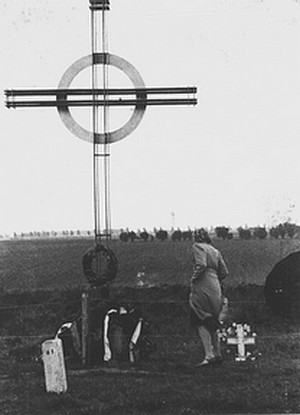 in September 1945 when Colonel Szydlowski came to Axel with 300 of his soldiers. They were all lodged by citizens. The Poles brought also a large Dragoon’s cross. It was made of aluminium from a destroyed German airplane and it was erected near the location where so many of them were killed. What they did not realize was that the quality of the alluminium of the german aircraft was not very good. After a couple of years the original cross started to deterionate so a “Axel-Polen” group decided to replace it by a solid steel version with a zinc coating. After all these years it still stands proud and undamaged and it is one of the locations where every year flowers are brought in order to keep the memory alive of what the Poles did for us.
in September 1945 when Colonel Szydlowski came to Axel with 300 of his soldiers. They were all lodged by citizens. The Poles brought also a large Dragoon’s cross. It was made of aluminium from a destroyed German airplane and it was erected near the location where so many of them were killed. What they did not realize was that the quality of the alluminium of the german aircraft was not very good. After a couple of years the original cross started to deterionate so a “Axel-Polen” group decided to replace it by a solid steel version with a zinc coating. After all these years it still stands proud and undamaged and it is one of the locations where every year flowers are brought in order to keep the memory alive of what the Poles did for us.
Dragon Cross (Dragonderkruis).
(The man in the middle of the group, with his hand up, is Mr. Jaap Geensen)
One of the surprises for the Polish soldiers was, that during the meeting in front of the City Hall, the people from Axel were singing: Jeszcze Polska nie zginęła. That was quite an emotional moment for them.
Dutch people greeting 1st PAD soldiers
In 1947 eight citizens from Axel received a Polish decoration. (One Merit Cross with Swords in Gold, one in Silver and one in Bronze).
Axel Residents are awar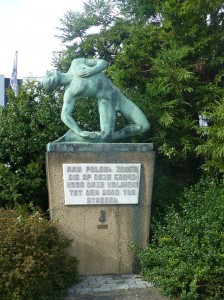 e of the fate of their liberators after the war, because the information they received on their return to the Polish were not good. This aroused deep sympathy for those who had nowhere to return to.In 1948 the liberation statue was placed on a strategic location, where you enter the town from the South, dedicated to “The sons of Poland that were fighting for our freedom and gave their lives on this very ground” The flowers on the Cemetery and near the Statue are red and white begonias, in the colours of Poland.
e of the fate of their liberators after the war, because the information they received on their return to the Polish were not good. This aroused deep sympathy for those who had nowhere to return to.In 1948 the liberation statue was placed on a strategic location, where you enter the town from the South, dedicated to “The sons of Poland that were fighting for our freedom and gave their lives on this very ground” The flowers on the Cemetery and near the Statue are red and white begonias, in the colours of Poland.
The wife of Colonel Szydlowski had been killed in a car accident in Germany and when the Division was to leave Germany the Colonel asked permission to bury his wife in Axel. The answer was that “It would be an honour and it shows the mutual band we have”. She was buried on October 1947 in the Catholic Cemetery.
Colonel Szydlowski was made a honorary citizen (the first in the town’s long history) in September 1945 and in 1949 he received a Royal decoration. Also a memorial corner was built on the Szydlowski Square, nowadays a place where many of the citizens do their shopping.
New Col. Z. Szydłowski Monument (August 2016, design by Julia Platt))
Video relations of uncovering of the new monument on September 16th, 2016
Shortly after the war the Canadians started to exhume those who were fallen, to rebury them in Adegem (Belgium). The City Council of Axel insisted on having those Polish soldiers that fell near the Dragoon’s Cross to be buried in Axel in the Public Cemetary. So it happened.
Polish graves in the Axel cemetary
General Maczek opened the street which was named after him. Near the original bridgehead of the Dragoons there is now a Gdynia Museum. In the last years it has been the focus of annual celebrations. One of the things that is done is that the oldest children from the elementary schools are picked up by classic military trucks and brought to the museum and the Dragoon’s Cross where they are told the story of what happend there in September 1944.
Axel viert de bevrijding van 69 jaar geleden (Dutch).
Through the years many of the Polish veterans kept coming to Axel in September in order to be present at the ceremonies in honour of their fallen comrades. After 1994, the 50th anniversary, the committee realized that in the near future less and less veterans would be able to attend and they decided that it would be wise to scale down to some smaller events. But one thing is certain: they have not been and will not be forgotten by the citizens of that small town in Zeeuws-Vlaanderen.
On September 19, 2019, on the 75th anniversary of the Battle of Axel, a special wreath-laying ceremony took place with the participation of the city authorities, Polish delegations, including representatives of the Polish embassy, as well as the local community [gr]
Jaap Geensen
Read also: Axel 1944, Polish success underexposed, Wreck in the IJsselmeer,
* This is how General Stanislaw Maczek recalls the attitude of the Dutch: “Very valuable for soldiers of the division was enthusiasm of the population especially of the city Axel, the warmth and hospitality of the Dutch… Polish soldiers were greeted with joy and enthusiasm, exceeding all, what happened to him, not only in France, but also in the hospitable Flanders; he felt like home in their own country … “.
About the author:
 The author Jaap Geensen is an amateur-historian and -archeologist. He is especially interested in the local history and has published several articles about Zeeuws-Vlaanderen during the second world war. He was born there and returned after he retired.
The author Jaap Geensen is an amateur-historian and -archeologist. He is especially interested in the local history and has published several articles about Zeeuws-Vlaanderen during the second world war. He was born there and returned after he retired.
Photo: Jaap Geensen, Author’s archive, Wikipedia, “De strijd om Axel ” by Colonel Dr. Z.M. Szydlowski D.S.O. issued in 1949 by J.C. Vink Axel (photo of. Col. Zdzisław Szydłowski)
Published: September 16, 2014 / Update: September 22, 2019




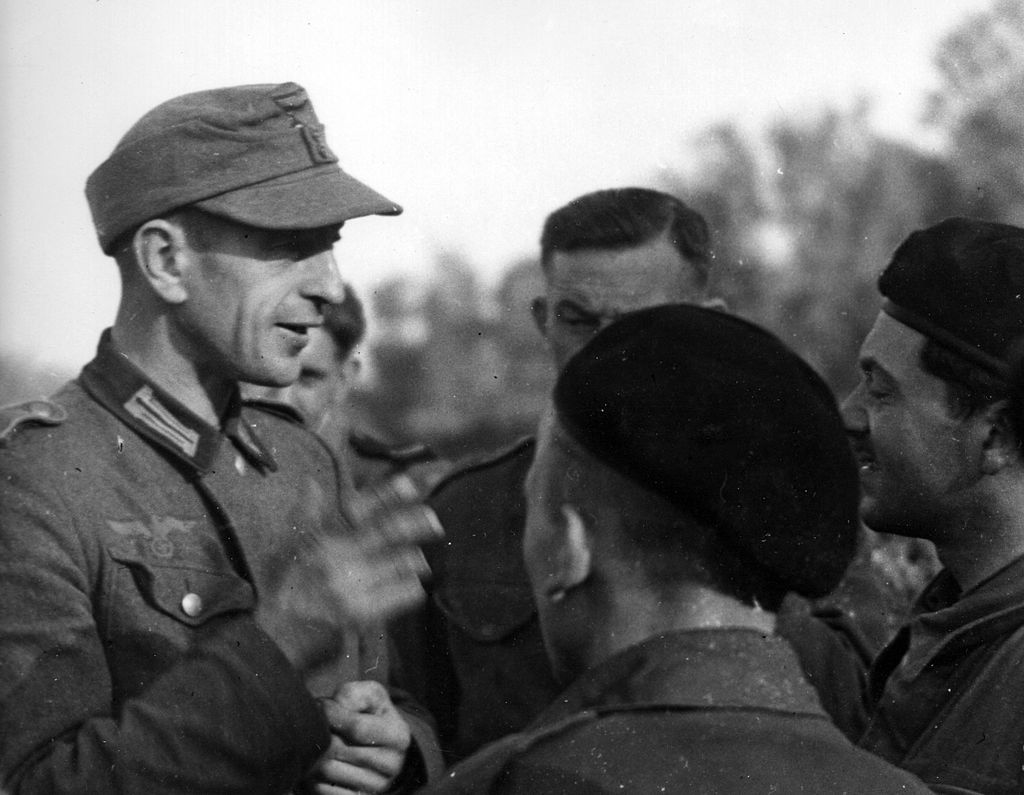



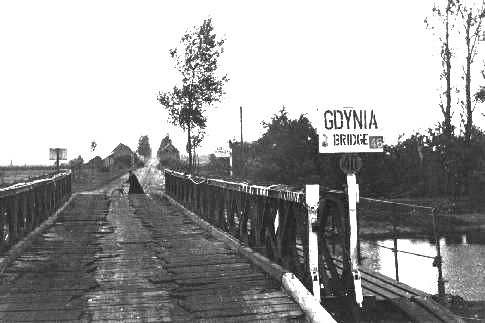







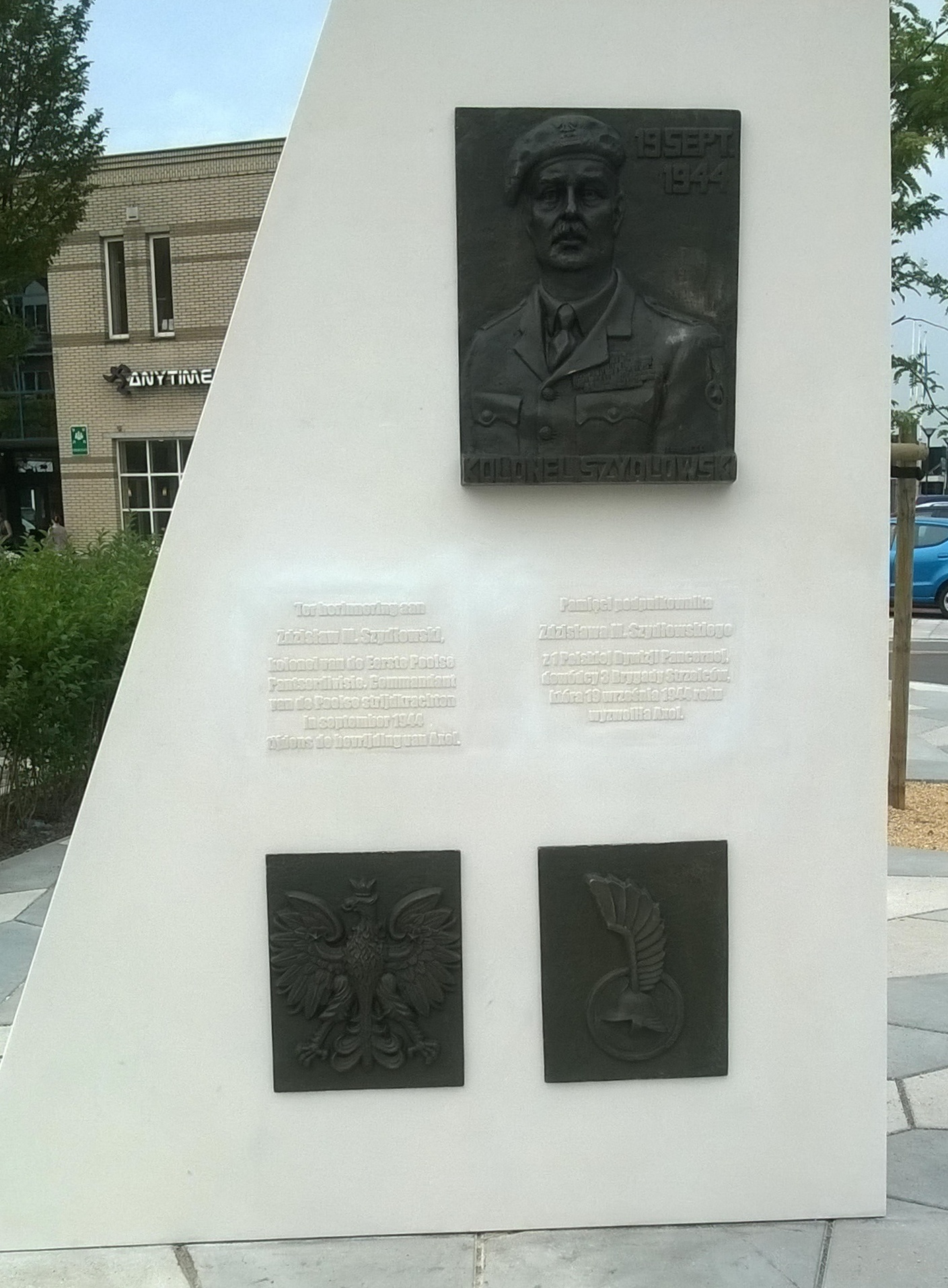
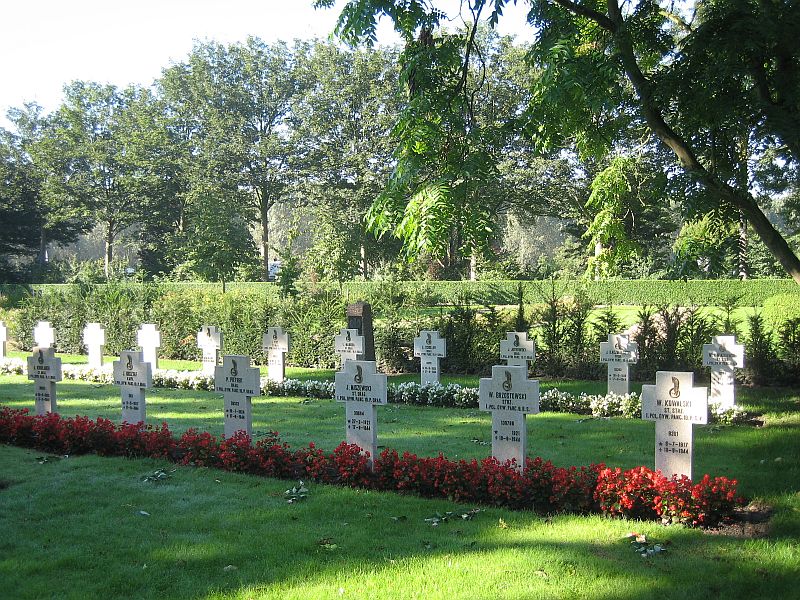


It was very heartwarming for me to discover and read the story on this website including references to my grandfather and grandmother Colonel Szydlowski and Anna Szydlowski. My thanks to Mr. Geensen and the Dutch people for keeping the memory of this history alive.
Dear Mr. Rabenda, I am very happy that you like this story and it was our good luck to get help from Jaap Geensen who is a great historian amateur and knows much about Polish military activities in Holland during WW II. Seems that many Dutch people are still very grateful for what Polish soldiers did to liberate Holland and those older ones really have this story alive. For me, as a Polish woman, it was a kind of nice surprise.
Thank you for positive comment – it is a big honour for our website!